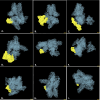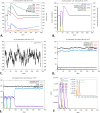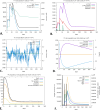An mRNA vaccine for pancreatic cancer designed by applying in silico immunoinformatics and reverse vaccinology approaches
- PMID: 38976715
- PMCID: PMC11230540
- DOI: 10.1371/journal.pone.0305413
An mRNA vaccine for pancreatic cancer designed by applying in silico immunoinformatics and reverse vaccinology approaches
Abstract
Pancreatic ductal adenocarcinoma is the most prevalent pancreatic cancer, which is considered a significant global health concern. Chemotherapy and surgery are the mainstays of current pancreatic cancer treatments; however, a few cases are suitable for surgery, and most of the cases will experience recurrent episodes. Compared to DNA or peptide vaccines, mRNA vaccines for pancreatic cancer have more promise because of their delivery, enhanced immune responses, and lower proneness to mutation. We constructed an mRNA vaccine by analyzing S100 family proteins, which are all major activators of receptors for advanced glycation end products. We applied immunoinformatic approaches, including physicochemical properties analysis, structural prediction and validation, molecular docking study, in silico cloning, and immune simulations. The designed mRNA vaccine was estimated to have a molecular weight of 165023.50 Da and was highly soluble (grand average of hydropathicity of -0.440). In the structural assessment, the vaccine seemed to be a well-stable and functioning protein (Z score of -8.94). Also, the docking analysis suggested that the vaccine had a high affinity for TLR-2 and TLR-4 receptors. Additionally, the molecular mechanics with generalized Born and surface area solvation analysis of the "Vaccine-TLR-2" (-141.07 kcal/mol) and "Vaccine-TLR-4" (-271.72 kcal/mol) complexes also suggests a strong binding affinity for the receptors. Codon optimization also provided a high expression level with a GC content of 47.04% and a codon adaptation index score 1.0. The appearance of memory B-cells and T-cells was also observed over a while, with an increased level of helper T-cells and immunoglobulins (IgM and IgG). Moreover, the minimum free energy of the mRNA vaccine was predicted at -1760.00 kcal/mol, indicating the stability of the vaccine following its entry, transcription, and expression. This hypothetical vaccine offers a groundbreaking tool for future research and therapeutic development of pancreatic cancer.
Copyright: © 2024 Masum et al. This is an open access article distributed under the terms of the Creative Commons Attribution License, which permits unrestricted use, distribution, and reproduction in any medium, provided the original author and source are credited.
Conflict of interest statement
The authors have declared that no competing interests exist
Figures












Similar articles
-
Immunoinformatics design of a novel epitope-based vaccine candidate against dengue virus.Sci Rep. 2021 Oct 5;11(1):19707. doi: 10.1038/s41598-021-99227-7. Sci Rep. 2021. PMID: 34611250 Free PMC article.
-
Exploring whole proteome to contrive multi-epitope-based vaccine for NeoCoV: An immunoinformtics and in-silico approach.Front Immunol. 2022 Aug 3;13:956776. doi: 10.3389/fimmu.2022.956776. eCollection 2022. Front Immunol. 2022. PMID: 35990651 Free PMC article.
-
Designing novel multiepitope mRNA vaccine targeting Hendra virus (HeV): An integrative approach utilizing immunoinformatics, reverse vaccinology, and molecular dynamics simulation.PLoS One. 2024 Oct 23;19(10):e0312239. doi: 10.1371/journal.pone.0312239. eCollection 2024. PLoS One. 2024. PMID: 39441880 Free PMC article.
-
The use of databases, data mining and immunoinformatics in vaccinology: where are we?Expert Opin Drug Discov. 2018 Feb;13(2):117-130. doi: 10.1080/17460441.2018.1413088. Epub 2017 Dec 11. Expert Opin Drug Discov. 2018. PMID: 29226722 Review.
-
Insights into structural vaccinology harnessed for universal coronavirus vaccine development.Clin Exp Vaccine Res. 2024 Jul;13(3):202-217. doi: 10.7774/cevr.2024.13.3.202. Epub 2024 Jul 31. Clin Exp Vaccine Res. 2024. PMID: 39144127 Free PMC article. Review.
Cited by
-
Toll-Like Receptors in the Immunotherapy Era: Dual-Edged Swords of Tumor Immunity and Clinical Translation.MedComm (2020). 2025 Jul 27;6(8):e70308. doi: 10.1002/mco2.70308. eCollection 2025 Aug. MedComm (2020). 2025. PMID: 40727252 Free PMC article. Review.
-
Revolutionizing Chikungunya Vaccines: mRNA Breakthroughs With Molecular and Immune Simulations.Bioinform Biol Insights. 2025 Apr 3;19:11779322251324859. doi: 10.1177/11779322251324859. eCollection 2025. Bioinform Biol Insights. 2025. PMID: 40182080 Free PMC article.
-
Computational design of a glycosylated multi-epitope vaccine against HAsV-1 and HAsV-2 astrovirus for acute gastroenteritis.Sci Rep. 2025 Apr 22;15(1):13954. doi: 10.1038/s41598-025-96989-2. Sci Rep. 2025. PMID: 40263512 Free PMC article.
-
Advancing therapeutic vaccines for chronic hepatitis B: Integrating reverse vaccinology and immunoinformatics.World J Hepatol. 2025 Jul 27;17(7):107620. doi: 10.4254/wjh.v17.i7.107620. World J Hepatol. 2025. PMID: 40747216 Free PMC article. Review.
-
Bioinformatics analysis of innovative multi-epitope vaccine utilizing MAGE-A, MAM-A, and Gal-3 for breast cancer management.Sci Rep. 2025 Jun 5;15(1):19774. doi: 10.1038/s41598-025-04089-y. Sci Rep. 2025. PMID: 40473741 Free PMC article.
References
MeSH terms
Substances
LinkOut - more resources
Full Text Sources
Medical
Miscellaneous

